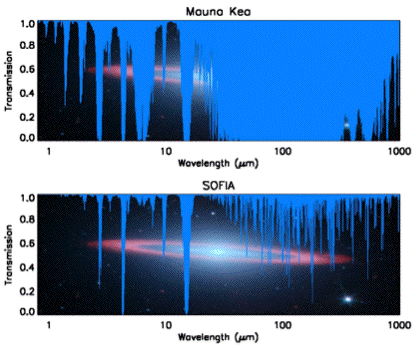The following graph shows the total transmission of radiation above a mountain and above a jet flying at 12,500 m. We took the graph from SOPHIA, Becklin et al. The authors of the graph assume 1 mm of water above the mountain and 10 μm above the jet (we refer here to the depth of liquid water sufficient to provide the water vapor).

Despite the galaxy in the background, we like this graph because it is not smoothed out like the others we have found. Because the upper graph corresponds to a hundred times more water vapor than the lower graph, the absorption it shows is a hundred times greater. The lower 1000 m of the Earth's atmosphere will almost always contain well over 10 mm of water vapor, so absorption in the entire thickness of the Earth's atmosphere will almost always be ten times greater than in the upper graph.
From these graphs, it appears that Earth's atmosphere is transparent to most wavelengths in the range 8−13 μm. For detail of the transparent band, see our previous post. Looking at one of our earlier graphs, we see that the Earth's radiation lies almost entirely within the range 6−30 μm. The atmosphere is transparent to 8−13 μm, but black to 6−8 μm and 13−30 μm. To the first approximation, the cloudless atmosphere is transparent to the Earth's radiation in the band 8−13 μm, and black elsewhere.
When there are no clouds above the Earth's surface, radiation within the 8−13 μm band will travel straight through the atmosphere and into space. Radiation outside this band will be absorbed. The upper atmosphere, meanwhile, will radiate its own heat into space. According to the principle of radiative symmetry, the atmosphere will radiate only at wavelengths where it is not transparent. Thus a cloudless atmosphere will be radiating heat of wavelengths 6−8 μm and 13−30 μm, but none in the range 8−13 μm.
We must ask ourselves if the surface of the Earth is a good radiator at wavelengths 8−13 μm. Two thirds of the Earth is covered with water, and we have already seen that water is black to all infrared frequencies. By radiative symmetry, the oceans will be black-body emitters of infrared. Those parts of the earth covered by snow and ice will be the same. We are not sure about trees and rock and sand, but taken as a whole, we conclude that the Earth's surface is a good black-body radiator of infrared.
So far we have considered an atmosphere without clouds. But if the atmosphere contains clouds, these will absorb all the Earth's radiation. Clouds contain microscopic drops of water, and liquid water is indeed black to all infrared frequencies. And the clouds will radiate at all infrared frequencies, just like the Earth. Their radiation will be absorbed by the upper atmosphere in the same way as the Earth's radiation.
Let us look at the behavior of the Earth with respect to 12-μm infrared, to which the cloudless atmosphere is transparent. The sun's radiation contains hardly any 12-μm infrared. The Earth's radiation contains plenty of 12-μm infrared. From outer space, we will see 12-μm radiation coming directly from the Earth's surface through a cloudless atmosphere, or we will see 12-μm radiation coming from cloud-tops.
Consider 20-μm infrared, to which the cloudless atmosphere is black. Very little 20-μm infrared arrives from the sun, but the Earth emits plenty of it. All of it is absorbed by the atmosphere. From outer-space, we will see 20-μm radiation from the upper layers of the atmosphere only.
Tthe Earth has three possible radiating surfaces: the upper atmosphere, the cloud-tops, or the surface of the Earth itself. In our next post, we will consider how these three surfaces influence the The Greenhouse Effect.

No comments:
Post a Comment